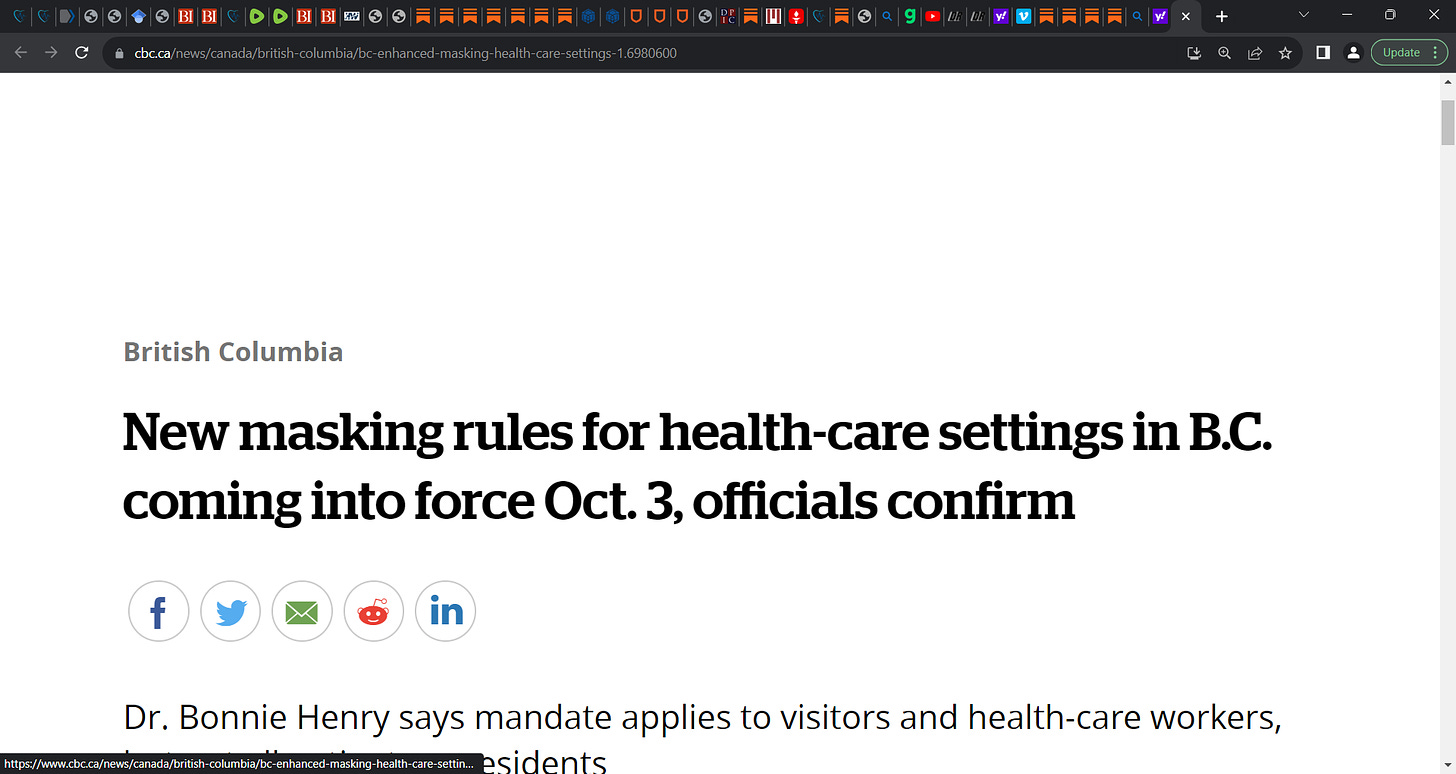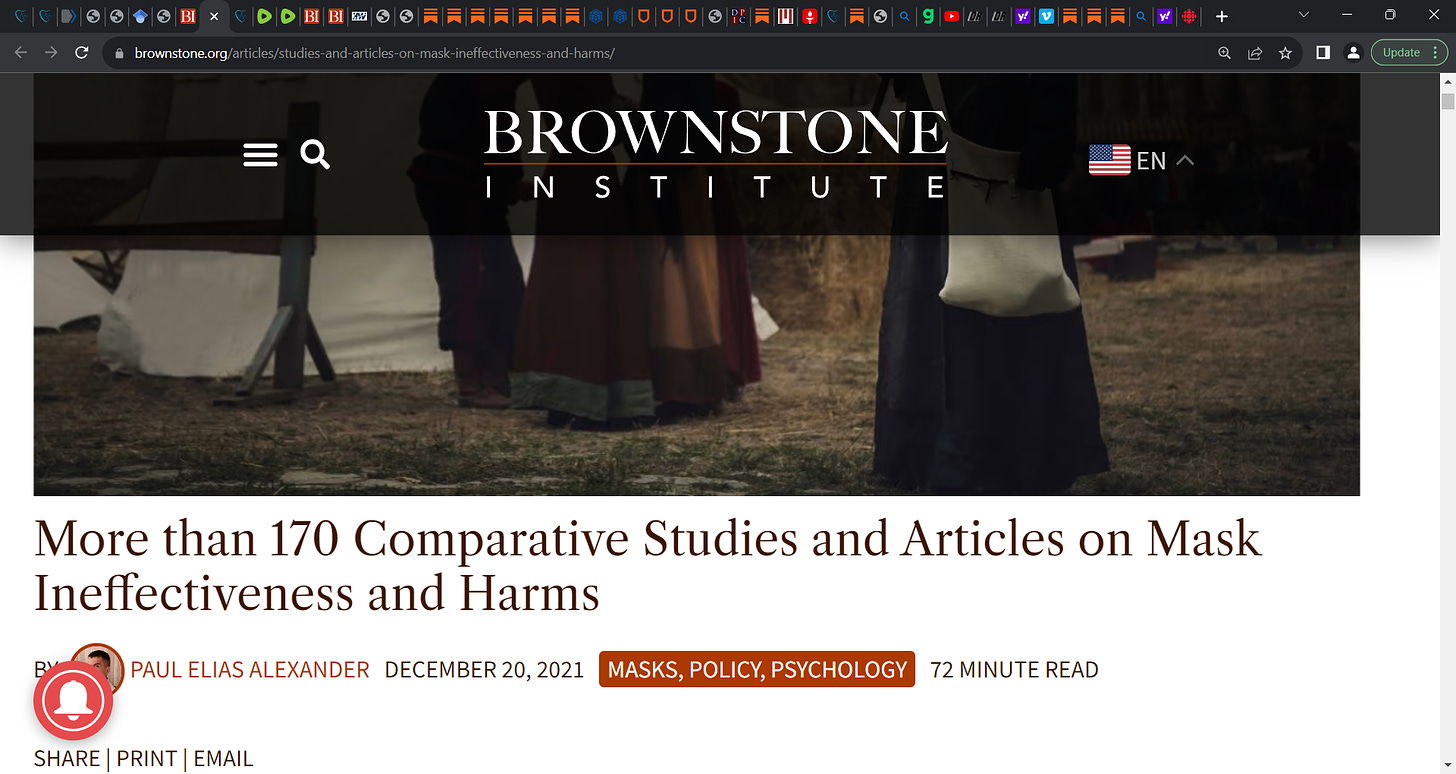NO!!! Tell them NO! They are coming in America & Canada & UK with lockdowns & masks again, to scare you to take the fraud failed Malone, Kariko, Weissman mRNA technology gene based vaccine by Moderna,
Pfizer, BioNTech (Sahin, Bourla, Bancel); tell them no!; ockdown mask lunatic Dr. Bonnie Henry of BC, Canada, is near orgasmic with masks again, she is having a COVID based orgasm, so a JACKASS AWARD!
Tell Bonnie, in all her COVID mask orgasmic pleasure, tell her to shove the masks…tell her Dr. Paul Alexander said ‘up yours Bonnie’…hopefully this lady gets thoroughly investigated and held to account for the madness she did across COVID
show her this, tell her she gets the double barrel:
What a lunatic this lady is, matched only by the health official loons in Doug Ford’s Ontario government, what a moron this lady is, matched and outdone only by the stupidity of Drs. Supriya Sharma and Theresa Tam of Health Canada and PHAC, and the grand master idiot in-chief Howard Njoo…what a bunch of academically sloppy, intellectually lazy, inane and vacuous, specious and unscientific egghead dolts for they clearly have spent 3.5 years never reading the science or the question is, maybe they are just too dumb, they cannot even understand the science…I will help these ding dongs by embedding some key reviews…AGAIN…these COVID Taliban, these COVID mandarins, these ex cathedra pandemicist COVIDian nutballs, are seeking to kill more people with lockdowns and closures and these baseless mandates that actually caused infections to rise, NOT fall.
Can this idiot Henry point to one study, just one, across COVID and before, that shows the masks worked to curb transmission or death? No, she can’t, but I can show you a review I did with 170 pieces of evidence showing the failure of masks and the harms…can’t she read?
Bonnie Henry makes CDC Director Dr. Rochelle Walensky (former) blush and quite frankly, besides a pure superb liar, Rochelle is maybe the dumbest person to head CDC (well, the verdict is out still on new CDC Director Dr. Mandy Cohen but she has already distinguished herself with idiocy straight out of the gate early in the running; Mandy may well surprise us and show us a depth of dumb and duplicity that will blow away Rochelle who will need to hand over the ‘liar’ crown) and only matched by the dimwit Ashish Jha (recall this idiocy by Jha: God made 2 arms, one for flu and one for COVID vaccine idiot), Biden’s COVID advisor. These people are not evil, but their dumbness makes them dangerous and quasi malfeasant.
They killed people across COVID with the lockdown lunacy and the fraud deadly mRNA vaccine and are at it again and Bonnie Henry is actually more stupid than Rochelle, if that could ever be possible. I will give Bonnie Henry the Jackass award for this week, making a complete fool and jackass of herself on the international stage, again making a laughing stock of Canada.
‘B.C. Provincial Health Officer Dr. Bonnie Henry and Health Minister Adrian Dix have announced that mandatory masking is returning to the province's health-care facilities next week as the number of COVID-19 cases continues to rise.
Thursday's news confirms details provided in a leaked government memo obtained by CBC a day earlier, which stated that "continuous masking by health-care workers, visitors, contractors and volunteers in all patient, client and resident care areas" will start Oct. 3.’
https://www.cbc.ca/news/canada/british-columbia/bc-enhanced-masking-health-care-settings-1.6980600
‘It is not unreasonable to conclude that surgical and cloth masks, used as they currently are being used (without other forms of PPE protection), have no impact on controlling the transmission of Covid-19 virus. Current evidence implies that face masks can be actually harmful. The body of evidence indicates that face masks are largely ineffective.
My focus is on COVID face masks and the prevailing science that we have had for nearly 20 months. Yet I wish to address this mask topic at a 50,000-foot level on the lockdown restrictive policies in general. I build on the backs of the fine work done by Gupta, Kulldorff, and Bhattacharya on the Great Barrington Declaration (GBD) and similar impetus by Dr. Scott Atlas (advisor to POTUS Trump) who, like myself, was a strong proponent for a focused type of protection that was based on an age-risk stratified approach.
Because we saw very early on that the lockdowns were the single greatest mistake in public health history. We knew the history and knew they would not work. We also knew very early of COVID’s risk stratification. Sadly, our children will bear the catastrophic consequences and not just educationally, of the deeply flawed school closure policy for decades to come (particularly our minority children who were least able to afford this). Many are still pressured to wear masks and punished for not doing so.
I present the masking ‘body of evidence’ below (n=167 studies and pieces of evidence), comprised of comparative effectiveness research as well as related evidence and high-level reporting. To date, the evidence has been stable and clear that masks do not work to control the virus and they can be harmful and especially to children.
Table 1: The evidence on COVID-19 face masks and mask mandates and harms
e.g. of some of the 170 pieces of evidence:
1) Effectiveness of Adding a Mask Recommendation to Other Public Health Measures to Prevent SARS-CoV-2 Infection in Danish Mask Wearers, Bundgaard, 2021“Infection with SARS-CoV-2 occurred in 42 participants recommended masks (1.8%) and 53 control participants (2.1%). The between-group difference was −0.3 percentage point (95% CI, −1.2 to 0.4 percentage point; P = 0.38) (odds ratio, 0.82 [CI, 0.54 to 1.23]; P = 0.33). Multiple imputation accounting for loss to follow-up yielded similar results…the recommendation to wear surgical masks to supplement other public health measures did not reduce the SARS-CoV-2 infection rate among wearers by more than 50% in a community with modest infection rates, some degree of social distancing, and uncommon general mask use.”
2) SARS-CoV-2 Transmission among Marine Recruits during Quarantine, Letizia, 2020“Our study showed that in a group of predominantly young male military recruits, approximately 2% became positive for SARS-CoV-2, as determined by qPCR assay, during a 2-week, strictly enforced quarantine. Multiple, independent virus strain transmission clusters were identified…all recruits wore double-layered cloth masks at all times indoors and outdoors.”
3) Physical interventions to interrupt or reduce the spread of respiratory viruses, Jefferson, 2020“There is low certainty evidence from nine trials (3507 participants) that wearing a mask may make little or no difference to the outcome of influenza‐like illness (ILI) compared to not wearing a mask (risk ratio (RR) 0.99, 95% confidence interval (CI) 0.82 to 1.18. There is moderate certainty evidence that wearing a mask probably makes little or no difference to the outcome of laboratory‐confirmed influenza compared to not wearing a mask (RR 0.91, 95% CI 0.66 to 1.26; 6 trials; 3005 participants)…the pooled results of randomised trials did not show a clear reduction in respiratory viral infection with the use of medical/surgical masks during seasonal influenza.”
4) The Impact of Community Masking on COVID-19: A Cluster-Randomized Trial in Bangladesh, Abaluck, 2021
Heneghan et al. A cluster-randomized trial of community-level mask promotion in rural Bangladesh from November 2020 to April 2021 (N=600 villages, N=342,126 adults. Heneghan writes: “In a Bangladesh study, surgical masks reduced symptomatic COVID infections by between 0 and 22 percent, while the efficacy of cloth masks led to somewhere between an 11 percent increase to a 21 percent decrease. Hence, based on these randomized studies, adult masks appear to have either no or limited efficacy.”
5) Evidence for Community Cloth Face Masking to Limit the Spread of SARS-CoV-2: A Critical Review, Liu/CATO, 2021“The available clinical evidence of facemask efficacy is of low quality and the best available clinical evidence has mostly failed to show efficacy, with fourteen of sixteen identified randomized controlled trials comparing face masks to no mask controls failing to find statistically significant benefit in the intent-to-treat populations. Of sixteen quantitative meta-analyses, eight were equivocal or critical as to whether evidence supports a public recommendation of masks, and the remaining eight supported a public mask intervention on limited evidence primarily on the basis of the precautionary principle.”
6) Nonpharmaceutical Measures for Pandemic Influenza in Nonhealthcare Settings—Personal Protective and Environmental Measures, CDC/Xiao, 2020“Evidence from 14 randomized controlled trials of these measures did not support a substantial effect on transmission of laboratory-confirmed influenza…none of the household studies reported a significant reduction in secondary laboratory-confirmed influenza virus infections in the face mask group…the overall reduction in ILI or laboratory-confirmed influenza cases in the face mask group was not significant in either studies.”
7) CIDRAP: Masks-for-all for COVID-19 not based on sound data, Brosseau, 2020“We agree that the data supporting the effectiveness of a cloth mask or face covering are very limited. We do, however, have data from laboratory studies that indicate cloth masks or face coverings offer very low filter collection efficiency for the smaller inhalable particles we believe are largely responsible for transmission, particularly from pre- or asymptomatic individuals who are not coughing or sneezing…though we support mask wearing by the general public, we continue to conclude that cloth masks and face coverings are likely to have limited impact on lowering COVID-19 transmission, because they have minimal ability to prevent the emission of small particles, offer limited personal protection with respect to small particle inhalation, and should not be recommended as a replacement for physical distancing or reducing time in enclosed spaces with many potentially infectious people.”
8) Universal Masking in Hospitals in the Covid-19 Era, Klompas/NEJM, 2020“We know that wearing a mask outside health care facilities offers little, if any, protection from infection. Public health authorities define a significant exposure to Covid-19 as face-to-face contact within 6 feet with a patient with symptomatic Covid-19 that is sustained for at least a few minutes (and some say more than 10 minutes or even 30 minutes). The chance of catching Covid-19 from a passing interaction in a public space is therefore minimal. In many cases, the desire for widespread masking is a reflexive reaction to anxiety over the pandemic…The calculus may be different, however, in health care settings. First and foremost, a mask is a core component of the personal protective equipment (PPE) clinicians need when caring for symptomatic patients with respiratory viral infections, in conjunction with gown, gloves, and eye protection…universal masking alone is not a panacea. A mask will not protect providers caring for a patient with active Covid-19 if it’s not accompanied by meticulous hand hygiene, eye protection, gloves, and a gown. A mask alone will not prevent health care workers with early Covid-19 from contaminating their hands and spreading the virus to patients and colleagues. Focusing on universal masking alone may, paradoxically, lead to more transmission of Covid-19 if it diverts attention from implementing more fundamental infection-control measures.”
9) Masks for prevention of viral respiratory infections among health care workers and the public: PEER umbrella systematic review, Dugré, 2020“This systematic review found limited evidence that the use of masks might reduce the risk of viral respiratory infections. In the community setting, a possible reduced risk of influenza-like illness was found among mask users. In health care workers, the results show no difference between N95 masks and surgical masks on the risk of confirmed influenza or other confirmed viral respiratory infections, although possible benefits from N95 masks were found for preventing influenza-like illness or other clinical respiratory infections. Surgical masks might be superior to cloth masks but data are limited to 1 trial.”
10) Effectiveness of personal protective measures in reducing pandemic influenza transmission: A systematic review and meta-analysis, Saunders-Hastings, 2017“Facemask use provided a non-significant protective effect (OR = 0.53; 95% CI 0.16–1.71; I2 = 48%) against 2009 pandemic influenza infection.”
11) Experimental investigation of indoor aerosol dispersion and accumulation in the context of COVID-19: Effects of masks and ventilation, Shah, 2021“Nevertheless, high-efficiency masks, such as the KN95, still offer substantially higher apparent filtration efficiencies (60% and 46% for R95 and KN95 masks, respectively) than the more commonly used cloth (10%) and surgical masks (12%), and therefore are still the recommended choice in mitigating airborne disease transmission indoors.”
12) Exercise with facemask; Are we handling a devil’s sword?- A physiological hypothesis, Chandrasekaran, 2020“Exercising with facemasks may reduce available Oxygen and increase air trapping preventing substantial carbon dioxide exchange. The hypercapnic hypoxia may potentially increase acidic environment, cardiac overload, anaerobic metabolism and renal overload, which may substantially aggravate the underlying pathology of established chronic diseases. Further contrary to the earlier thought, no evidence exists to claim the facemasks during exercise offer additional protection from the droplet transfer of the virus.”
13) Surgical face masks in modern operating rooms–a costly and unnecessary ritual?,Mitchell, 1991“Following the commissioning of a new suite of operating rooms air movement studies showed a flow of air away from the operating table towards the periphery of the room. Oral microbial flora dispersed by unmasked male and female volunteers standing one metre from the table failed to contaminate exposed settle plates placed on the table. The wearing of face masks by non-scrubbed staff working in an operating room with forced ventilation seems to be unnecessary.”
14) Facemask against viral respiratory infections among Hajj pilgrims: A challenging cluster-randomized trial, Alfelali, 2020“By intention-to-treat analysis, facemask use did not seem to be effective against laboratory-confirmed viral respiratory infections (odds ratio [OR], 1.4; 95% confidence interval [CI], 0.9 to 2.1, p = 0.18) nor against clinical respiratory infection (OR, 1.1; 95% CI, 0.9 to 1.4, p = 0.40).”
15) Simple respiratory protection–evaluation of the filtration performance of cloth masks and common fabric materials against 20-1000 nm size particles, Rengasamy, 2010“Results obtained in the study show that common fabric materials may provide marginal protection against nanoparticles including those in the size ranges of virus-containing particles in exhaled breath.”
16) Respiratory performance offered by N95 respirators and surgical masks: human subject evaluation with NaCl aerosol representing bacterial and viral particle size range, Lee, 2008“The study indicates that N95 filtering facepiece respirators may not achieve the expected protection level against bacteria and viruses. An exhalation valve on the N95 respirator does not affect the respiratory protection; it appears to be an appropriate alternative to reduce the breathing resistance.”
17) Aerosol penetration and leakage characteristics of masks used in the health care industry, Weber, 1993“We conclude that the protection provided by surgical masks may be insufficient in environments containing potentially hazardous sub-micrometer-sized aerosols.”
18) Disposable surgical face masks for preventing surgical wound infection in clean surgery, Vincent, 2016“We included three trials, involving a total of 2106 participants. There was no statistically significant difference in infection rates between the masked and unmasked group in any of the trials…from the limited results it is unclear whether the wearing of surgical face masks by members of the surgical team has any impact on surgical wound infection rates for patients undergoing clean surgery.”
19) Disposable surgical face masks: a systematic review, Lipp, 2005“From the limited results it is unclear whether wearing surgical face masks results in any harm or benefit to the patient undergoing clean surgery.”
20) Comparison of the Filter Efficiency of Medical Nonwoven Fabrics against Three Different Microbe Aerosols, Shimasaki , 2018“We conclude that the filter efficiency test using the phi-X174 phage aerosol may overestimate the protective performance of nonwoven fabrics with filter structure compared to that against real pathogens such as the influenza virus.”21) The use of masks and respirators to preventtransmission of influenza: a systematic review of thescientific evidence
21) The use of masks and respirators to prevent transmission of influenza: a systematic review of the scientific evidence, Bin-Reza, 2012The use of masks and respirators to preventtransmission of influenza: a systematic review of thescientific evidence“None of the studies established a conclusive relationship between mask/respirator use and protection against influenza infection. Some evidence suggests that mask use is best undertaken as part of a package of personal protection especially hand hygiene.”
22) Facial protection for healthcare workers during pandemics: a scoping review, Godoy, 2020“Compared with surgical masks, N95 respirators perform better in laboratory testing, may provide superior protection in inpatient settings and perform equivalently in outpatient settings. Surgical mask and N95 respirator conservation strategies include extended use, reuse or decontamination, but these strategies may result in inferior protection. Limited evidence suggests that reused and improvised masks should be used when medical-grade protection is unavailable.”
23) Assessment of Proficiency of N95 Mask Donning Among the General Public in Singapore, Yeung, 2020“These findings support ongoing recommendations against the use of N95 masks by the general public during the COVID-19 pandemic.5 N95 mask use by the general public may not translate into effective protection but instead provide false reassurance. Beyond N95 masks, proficiency among the general public in donning surgical masks needs to be assessed.”
24) Evaluating the efficacy of cloth facemasks in reducing particulate matter exposure, Shakya, 2017“Standard N95 mask performance was used as a control to compare the results with cloth masks, and our results suggest that cloth masks are only marginally beneficial in protecting individuals from particles<2.5 μm.”
25) Use of surgical face masks to reduce the incidence of the common cold among health care workers in Japan: a randomized controlled trial, Jacobs, 2009“Face mask use in health care workers has not been demonstrated to provide benefit in terms of cold symptoms or getting colds.”
26) N95 Respirators vs Medical Masks for Preventing Influenza Among Health Care Personnel, Radonovich, 2019 “Among outpatient health care personnel, N95 respirators vs medical masks as worn by participants in this trial resulted in no significant difference in the incidence of laboratory-confirmed influenza.”
27) Does Universal Mask Wearing Decrease or Increase the Spread of COVID-19?, Watts up with that? 2020“A survey of peer-reviewed studies shows that universal mask wearing (as opposed to wearing masks in specific settings) does not decrease the transmission of respiratory viruses from people wearing masks to people who are not wearing masks.”
28) Masking: A Careful Review of the Evidence, Alexander, 2021“In fact, it is not unreasonable at this time to conclude that surgical and cloth masks, used as they currently are, have absolutely no impact on controlling the transmission of Covid-19 virus, and current evidence implies that face masks can be actually harmful.”
29) Community and Close Contact Exposures Associated with COVID-19 Among Symptomatic Adults ≥18 Years in 11 Outpatient Health Care Facilities — United States, July 2020, Fisher, 2020Reported characteristics of symptomatic adults ≥18 years who were outpatients in 11 US academic health care facilities and who received positive and negative SARS-CoV-2 test results (N = 314)* — United States, July 1–29, 2020, revealed that 80% of infected persons wore face masks almost all or most of the time.
30) Impact of non-pharmaceutical interventions against COVID-19 in Europe: a quasi-experimental study, Hunter, 2020Face masks in public was not associated with reduced incidence.
31) Masking lack of evidence with politics, CEBM, Heneghan, 2020“It would appear that despite two decades of pandemic preparedness, there is considerable uncertainty as to the value of wearing masks. For instance, high rates of infection with cloth masks could be due to harms caused by cloth masks, or benefits of medical masks. The numerous systematic reviews that have been recently published all include the same evidence base so unsurprisingly broadly reach the same conclusions.”
32) Transmission of COVID-19 in 282 clusters in Catalonia, Spain: a cohort study, Marks, 2021“We observed no association of risk of transmission with reported mask usage by contacts, with the age or sex of the index case, or with the presence of respiratory symptoms in the index case at the initial study visit.”
33) Non-pharmaceutical public health measures for mitigating the risk and impact of epidemic and pandemic influenza, WHO, 2020“Ten RCTs were included in the meta-analysis, and there was no evidence that face masks are effective in reducing transmission of laboratory-confirmed influenza.”
34) The Strangely Unscientific Masking of America, Younes, 2020“One report reached its conclusion based on observations of a “dummy head attached to a breathing simulator.” Another analyzed use of surgical masks on people experiencing at least two symptoms of acute respiratory illness. Incidentally, not one of these studies involved cloth masks or accounted for real-world mask usage (or misusage) among lay people, and none established efficacy of widespread mask-wearing by people not exhibiting symptoms. There was simply no evidence whatsoever that healthy people ought to wear masks when going about their lives, especially outdoors.”
35) Facemasks and similar barriers to prevent respiratory illness such as COVID-19: A rapid systematic review, Brainard, 2020“31 eligible studies (including 12 RCTs). Narrative synthesis and random-effects meta-analysis of attack rates for primary and secondary prevention in 28 studies were performed. Based on the RCTs we would conclude that wearing facemasks can be very slightly protective against primary infection from casual community contact, and modestly protective against household infections when both infected and uninfected members wear facemasks. However, the RCTs often suffered from poor compliance and controls using facemasks.”
36) The Year of Disguises, Koops, 2020“The healthy people in our society should not be punished for being healthy, which is exactly what lockdowns, distancing, mask mandates, etc. do…Children should not be wearing face coverings. We all need constant interaction with our environments and that is especially true for children. This is how their immune system develops. They are the lowest of the low-risk groups. Let them be kids and let them develop their immune systems… The “Mask Mandate” idea is a truly ridiculous, knee-jerk reaction and needs to be withdrawn and thrown in the waste bin of disastrous policy, along with lockdowns and school closures. You can vote for a person without blindly supporting all of their proposals!”
37) Open Schools, Covid-19, and Child and Teacher Morbidity in Sweden, Ludvigsson, 2020“1,951,905 children in Sweden (as of December 31, 2019) who were 1 to 16 years of age, were examined…social distancing was encouraged in Sweden, but wearing face masks was not…No child with Covid-19 died.”
38) Double-Masking Benefits Are Limited, Japan Supercomputer Finds, Reidy, 2021“Wearing two masks offers limited benefits in preventing the spread of droplets that could carry the coronavirus compared to one well-fitted disposable mask, according to a Japanese study that modeled the dispersal of droplets on a supercomputer.”
39) Physical interventions to interrupt or reduce the spread of respiratory viruses. Part 1 – Face masks, eye protection and person distancing: systematic review and meta-analysis, Jefferson, 2020“There was insufficient evidence to provide a recommendation on the use of facial barriers without other measures. We found insufficient evidence for a difference between surgical masks and N95 respirators and limited evidence to support effectiveness of quarantine.”
…






No comments:
Post a Comment